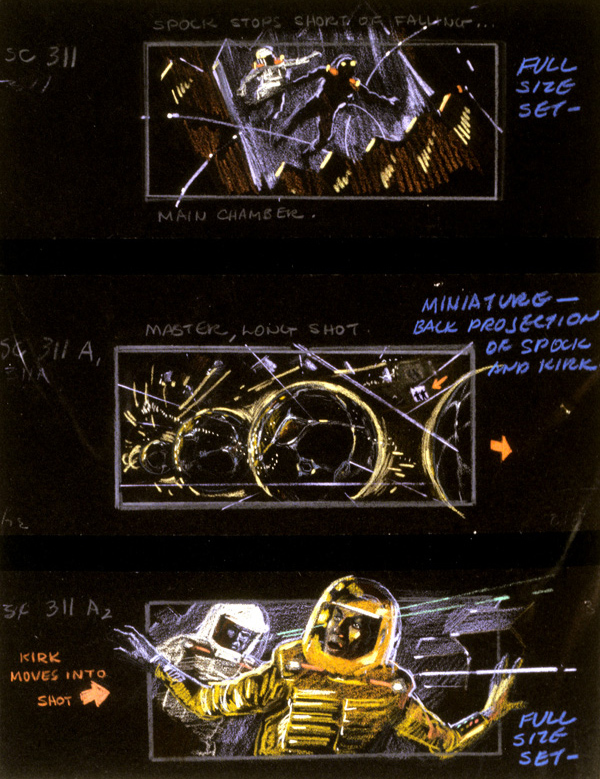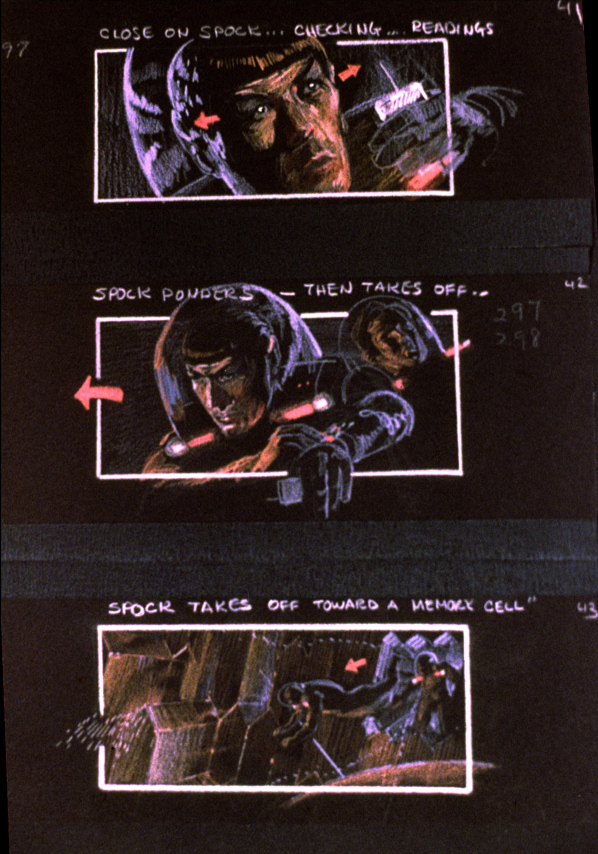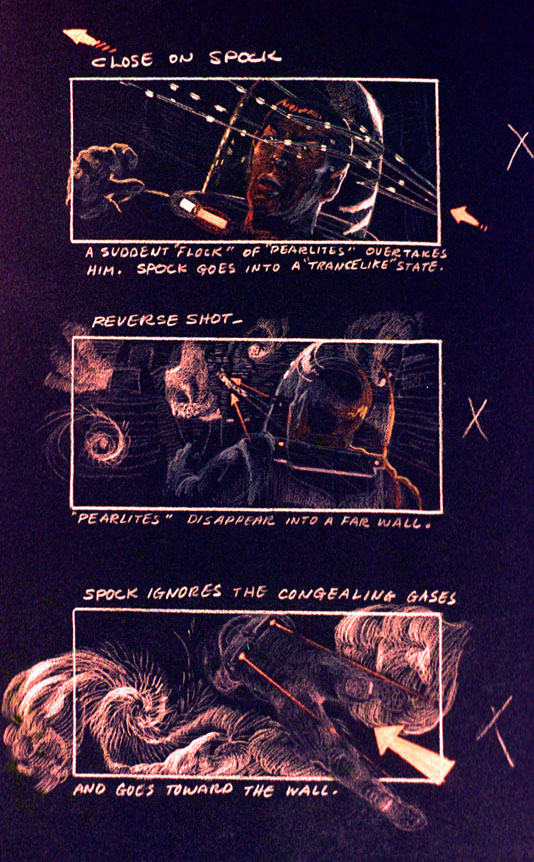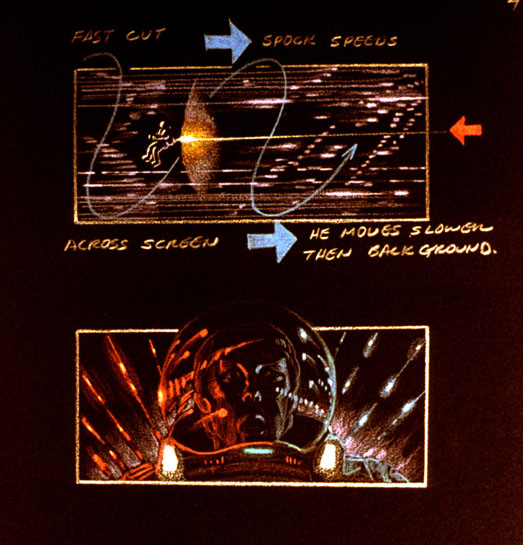Interview with David J. Negrón

David J. Negrón has had a long career in the arts. Educated at the renowned Art Center College of Design in Los Angeles, Negrón worked for years in the film industry before taking on an instructor position at the same institution.
His experience in motion pictures includes work in the Art Departments of Jurassic Park, Rambo III, Raiders of the Lost Ark and Star Trek: The Motion Picture, on which he worked first alongside Richard Taylor and later for John Dykstra and Douglas Trumbull on the design of V’Ger.
Interview
Can you tell us about your background as an artist in the film industry? You have an impressive resume, having worked on the 1976 King Kong, Innerspace, Masters of the Universe, Ghost, Rambo III, Jurassic Park and Raiders of the Lost Ark, to name a few. Was it always your ambition to work in the film industry as an illustrator?
I came to Los Angeles to attend what was then the best commercial art school in the country. I wanted an education that would provide me with the skills to be an art director in an ad agency or art director in the movie business. The movie business was pretty much a dream, but art direction in advertising in Texas was a very real possibility after graduating from Art Center College of Design in LA.
After the money ran out while I was doing graduate work at Art Center, my illustration instructor help me get an interview for an opening as an illustrator at 20th Century Fox — went on Friday and was working the following Monday earning three times as much as my old job in Texas as a director of student activities at Baylor University in Waco. Needless to say my movie career began.
At Fox, I teamed up with a production designer, John De Cuir, who was getting assigned to the biggest and best movies being produced. I learned a lot from this gentleman and advanced very quickly, and became recognized for the knowledge that I had acquired with John. As an illustrator, I was earning just as much money as some of the art directors without the administrative headaches. So, I never thought any more about becoming an art director until I was granted that title almost by default — I was more of an art consultant without the usual responsibilities of running an art department.
That is very impressive! As an artist, do you have a preferred media? Pen and ink, paint, etc?
My favorite media at present is oils, but as a movie illustrator I used the media that best worked for the assignment at hand. For instance, working on Star Trek: The Motion Picture, I worked mainly with color pencils on high-quality matt black board. It lent itself to showing elements well against the void of space. Today, I do paintings for galleries. The permanency and breath of scope that oils provide gives me the freedom to bring all the experience of my years in the movies to a very satisfactory conclusion.
Your artwork is astounding. Both your work for film and the artwork that is available for purchase in your gallery. The level of detail and photo-realism is dazzling. Can you tell us how you became involved with Star Trek: The Motion Picture — and when? I know it has been a few years since then, but any recollections you have from those days and that particular job would be great! Did you watch Star Trek prior to working on the film? Would you call yourself a fan or casual viewer?
Bob Abel contacted me when he had been working on the movie for several months. He was having trouble communicating his ideas to the Paramount executives using presentation techniques he was used to with advertising types.
Making movies is a question of getting the best look with past and proven methods and effects to determine expense and working with a reasonable predictable budget. Bob was exploring and experimenting a lot to get the most fantastic visuals. Paramount started to lose faith that Abel was going to deliver and decided to hire [Robert] Wise and [Douglas] Trumbull to finish the project. Though I was able to put many of Bob Abel’s ideas down, I believe it was too little too late.
Bob Wise and Doug [Trumbull] reviewed my work and drawing and were very impressed to the extent that they collected them all and kept me on to continue working to the end of the film. Many of the old ideas were adjusted to fit the new effects methods and budget requirements.
You can consider me a casual viewer of Star Trek. But as soon as I got hired, I quickly got up to speed and learned much. There is still a lot that I don’t know about Star Trek but I certainly have a great appreciation for the total concept.
If I have my facts/history straight, I believe you worked for Robert Abel and Associates under the supervision of Richard Taylor as senior illustrator. Can you describe your duties on the film, your typical workday, and the environment of working with them on Star Trek at that time?
Richard Taylor was astonishingly creative in an unorthodox way with new visuals. He was experimenting with many new concepts that the movies had yet to discover or incorporate. We shared many ideas and ways of helping Paramount to understand how these ideas would work in the movie. The script was broken down into sections that were assigned to different illustrators and we developed both the storyline storyboard concept and visual effects for each board. We had models, architectural drawings and reference material by the “truck load.”
I felt a little out of place, since I had just met everyone at Abel’s for the first time. They were all very friendly and I soon became one of the family.
How involved were you with the planning of the unique visual effects RA&A had planned for the film? Did you actually see any of the work completed by the visual effects team? If so, what was your impression?
Both the Abel team and Trumbull were very willing and interested in discussing with me how special effects worked and new ideas. They all knew that as a senior illustrator, I was instrumental in designing special effects for other movies such as King Kong. I used to take clips of test to my personal studio to do composite tests. Generally, I was very impressed with the final outcome, though I still see some glitches which were there originally and were never resolved.
Did you have any direct input into the design of the planned visual effects for the film? If so, please describe. From my 2001 interview with Richard Taylor, we learned that there were a number of spectacular sequences planned — some of which did not make it into the film after the dismissal of RA&A from the project — or at least as released (revisualized by Doug Trumbull and John Dykstra’s teams thereafter). Presumably, storyboards exist for all the sequences as RA&A had planned them. Were you responsible for these — and do you know if these still exist?
Yes, I did have direct input into the design of visual effects and I have a few of those sketches. Many of these sketches were taken by several people when Abel was taken over. I have several sketches from the sequence of Spock’s travel to the mind of V’Ger.






You graciously and generously provided artwork from the Star Trek: The Motion Picture Spock spacewalk sequence, which was shot by the Abel FX team and then reshot under the auspices of Douglas Trumbull after RA&A’s dismissal. Was this artwork from your tenure with Abel or Trumbull/Dykstra? I know our visitors would be interested seeing your work on the sequence from either team, but particularly from your work with Abel.
The spacewalk artwork was from both camps — both the Trumbull and the Abel studio.
Did you continue to work on The Motion Picture after RA&A were dismissed? I believe Andrew Probert was a holdover from the Abel studio who continued to work on the film when the new teams took over.
As I described above, I worked with Doug [Trumbull] after leaving Abel’s for the duration of the film.
Did you see the 2001 director’s cut of The Motion Picture? If so, what did you think of the results? If not, what did you think of the film as completed and released theatrically?
Yes I did, but didn’t notice too much difference between the director’s cut and the theatrical release. I have to take a closer look and compare anew.
To see the TV series transformed to the giant screen with effects that made the concept of Star Trek so much more believable was an awesome experience.
Are there any anecdotal stories from those days that you wouldn’t mind sharing with our visitors?
While working on movies, there were many incidents that linger in my memory. Sometimes they were quite funny.
In Star Trek, I remember that we had to improvise when Decker’s body was to glow during his transformation sequence. We stuck cotton balls along the edges of his body to help the light flare off his body. It became quite problematic when the cotton kept flying off, revealing exactly what it really was — cotton — it was very frustrating.
Your son worked worked on the last Star Trek feature, Nemesis, as an illustrator. So, not only does artistic ability run in the family but obviously the same can be said for Star Trek.
I am very proud of my son David. He worked on many films alongside me and he went on to become a special-effects supervisor, second unit director and storyboard artist.
When your son went on to work on Star Trek: Nemesis, did he come to you for any advise or suggestions with regard to working on Trek — given that you had worked on Star Trek: The Motion Picture? Did you guys talk about it or was it “just another day at the office”?
It was really the other way around. I came to him for advise about Star Trek since he was more of a devotee than I.
I remember that during my tour with Bob Abel, he also helped me with special-effects suggestions. We communicate quite a bit on most projects. Sometimes location situations makes it somewhat difficult for that to happen. I believe that during his work on Nemesis, I was working on Out of Time in Florida.
ou have worked in the industry for a long time, what would you say has changed the most about what you do today as opposed to back in the “old days”? Do you still tend to create art by hand using traditional methods and media or do computers now play a role?
Yes, I do work with computers, but I still contend that a traditional art education, drawing and painting, is essential for a creative person to communicate ideas. The movie artists of the 50s and 60s were first artist and then movie designers. Norman Rockwell, while visiting the sets and working on the movie poster for Stage Coach, could not believe the art talent required for designing movies. He said he had no idea and declared that he could not do what we were doing in the Art Department.

2 comments
Submit comments by email.